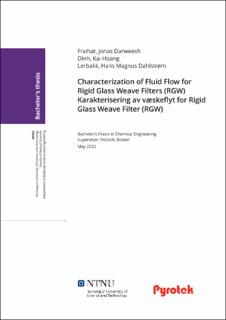| dc.contributor.advisor | Fritzsch, Robert | |
| dc.contributor.author | Fraihat, Jonas Darweesh | |
| dc.contributor.author | Dinh, Kai Hoang | |
| dc.contributor.author | Lerbakk, Hans Magnus Dahlstrøm | |
| dc.date.accessioned | 2022-07-09T17:20:19Z | |
| dc.date.available | 2022-07-09T17:20:19Z | |
| dc.date.issued | 2022 | |
| dc.identifier | no.ntnu:inspera:113586103:113587429 | |
| dc.identifier.uri | https://hdl.handle.net/11250/3004351 | |
| dc.description.abstract | Filtrering av metallinklusjoner er et viktig steg i støpningsprosessen for å forsikre renhetskravet. I denne forstand er utvikling av nye metallfiltreringsteknologier interessant. En slik teknologi er Rigid Glass Weave (RGW) som kan erstatte Ceramic Foam Filters (CFF) for bruk i støperi. Mens CFF er betydelig bedre ved lavere væskehastigheter, kan RGW håndtere veldig høye væskehastigheter samt den tilbyr andre fordeler for støpningsmaskiner. Fokuset til denne oppgaven er karakteriseringen av væskeflyten gjennom filteret. To geometrier med fem forskjellige vevstyper ble testet ved flere væskehastigheter i et trykkforskjellsforsøk. Der dataen ble brukt i et forsøk på å kvantifisere empiriske konstanter i henhold til Forchheimers likning. Fire metoder ble brukt i forsøkene for å kvantifisere disse verdiene: Lineær Regresjon, Ergun Empirisk, Eksponentialregresjon og Ren Gjetting. Verdiene fra den siste metoden ble brukt som forventningsverdier til å kvantifisere p--verdier til Lineær Regresjon Metoden og Ergun Empiriske metoden.
I tillegg, ble systemet modellert i 2D og 3D med COMSOL Multiphysics® for hver geometri. I begge 2D simuleringene ble filtrene behandlet som permeable medier, samt en geometri i 3D modellen. 3D modellen med det flate vevet ble modellert med individuelle vev, og simulert i samme respekt. | |
| dc.description.abstract | Filtration of metal inclusions is an important step in ensuring the castings meet the standards for cleanliness. In this respect the development of new metal filtration technology is of interest. One such technology is Rigid Glass Weave (RGW) which may replace the Ceramic Foam Filters (CFF) in foundry applications.
While CFF is significantly better at lower flowrates, the RGW can handle very high flowrates and offers other advantages for casting machines in general. The focus of this thesis is the characterization of the flow through this filter. Five different weaves across two geometries were tried at various flowrates in a pressure--drop experiment. And the data was used in an attempt at quantifying the empirical constants in regards to the Forchheimer equation. Four methods were used in attempting to quantify these constants: Linear Regression, Ergun Empirical, Exponential Regression, and Brute Force. Of these, the first three were a form of linear regression. The quantification of the last method was treated as the expected value and used to quantify the p--values for the Linear Regression Method and the Ergun Empirical Method.
In addition, the system with each geometry was modelled in 2D and 3D using COMSOL Multiphysics®. Both the 2D models were simulated using by treating both the filter geometries as permeable media, and one filter geometry for the 3D model. The 3D model with a flat weave was modelled as individual strands, and simulated as such. | |
| dc.language | eng | |
| dc.publisher | NTNU | |
| dc.title | Characterization of Fluid Flow for Rigid Glass Weave Filters (RGW) | |
| dc.type | Bachelor thesis | |
